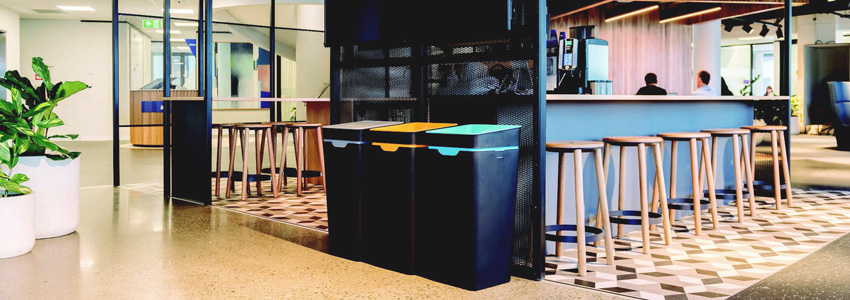Recycle more waste less
Method have transformed recycling for the modern workplace. Their innovative bins that are designed and made in New Zealand are helping organisations around the world to divert more waste from landfill.
Content created with help from our friends at Method.
How Your Office Can Recycle More, and Waste Less with Method
Open plan and agile workspaces have eclipsed closed offices and cubicles, and it’s necessary that waste management and recycling design evolves with workplace design.
Yet decisions about waste have long been neglected until the final hour, leading to systems that are ineffective, inconsistent with the building aesthetic, or hidden away from sight.
Under desk or hidden bins make it convenient for users to place the majority of their waste into bins that go to landfill; resulting in recyclables being disposed of at a higher cost. Further, if recycling bins are hidden it is less likely that people are going to actively consider their recycling habits.
Most people are aware of the need to recycle and we need to ensure that offices are making recycling easier than landfill options.
Driving around New Zealand selling generic bins, Method co-founders Steven and India Korner saw the need for better bin design in workplaces. They found a lot of apathy towards recycling, but also businesses who were striving to do the right thing, without the tools they needed to succeed. They spent 3 years researching the way facilities waste solutions worked and how users interact with them, they even assisted cleaners on night shifts for a holistic view.
All of this hard work paid off, resulting in the colour-coded and ultimately behaviour- changing Method 60L Office Recycling Bins. Designed for the modern workplace, they connect together to form flexible recycling stations that can be easily adapted to the needs of any building.
From this, Method pioneered the concept of open plan recycling, a theory centred around design, flexibility, and visibility. Bringing recycling and waste stations out into the open plan layout of modern spaces.
Design
Method believes in a recycling solution that is not an afterthought, but a part of the furniture. This requires extensive design and consideration, a purpose-built product that doesn’t detract from your facility design, but instead compliments it.
When you are considering open plan recycling for your facility, bins should be visually effective in communicating their use – as well as matching your interior design. Colour coding and the use of graphics can make bins identifiable at a glance. Make your bins consistent across all of your spaces and people will adapt through continued use and will no longer need to actively consider what stream items go into.
Centralised recycling stations mean purchasing considerably fewer bin liners than under desk bins, this also reduces the time cleaners need to service them. This can represent considerable savings for any facility.
Visibility + Flexibility
Visibility is one of the core principles that make open plan recycling effective. Recycling and waste stations should be easy to see, not hidden away. If bins are out in the open users are continuously reminded to consider their recycling behaviours within the space and enforces accountability.
When people know they’re being watched, even subconsciously, they tend to consider their decisions and are more likely to sort their waste accurately. Similarly, when people observe others correctly sorting their waste this can encourage them to do the same.
Visible recycling solutions send a message to stakeholders that you are serious about reducing the impact your organisation has on the environment.
Westpac NZ reduced their waste to landfill from 70% to 30% with the introduction of Method bins.
Open plan recycling should also be flexible. As an organisation grows and changes, the number of bins and where they are placed need to adapt to be successful. This includes placing bins in areas of waste production, such as an organics bin in the kitchen.
Engaging employees in recycling
Methods bins effectively change recycling behaviours. However, to optimise the recycling behaviours in your office you need to measure and record your waste, as well as engaging your employees.
Most people recycle at home, however, efforts often lack in the workplace. This is due in part to a lack of feedback, at home, we can see when we are sending more waste to landfill or using more power. Recording waste habits for a building and passing that information back to staff increases their awareness of how much they are using, engages them in conversations about recycling, and shows progress.
Diversion from landfill is a good indicator that is easy to measure on an ongoing basis. However, you are able to better identify areas of success and concern with increased measuring metrics, and completing waste audits frequently can provide you with rich data.
Start your workplace recycling journey with Method or find out more on our website - www.methodrecycling.com
For your office leasing needs:

